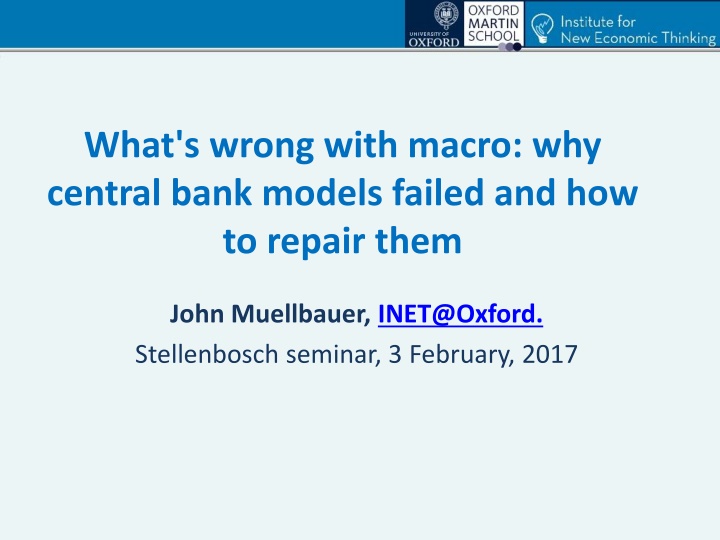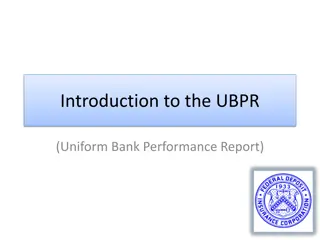Central Bank Models Failures and Repairs by John Muellbauer
In this insightful discussion, John Muellbauer addresses the failures of central bank models post-financial crisis and proposes ways to repair them. He critiques the choice of micro-foundations, inter-temporal optimization flaws, and neglect of financial architecture changes. Additionally, he highlights the milder critique by Blanchard on DSGE models dominating central bank thinking and advocates for alternative models closer to the data.
Download Presentation

Please find below an Image/Link to download the presentation.
The content on the website is provided AS IS for your information and personal use only. It may not be sold, licensed, or shared on other websites without obtaining consent from the author.If you encounter any issues during the download, it is possible that the publisher has removed the file from their server.
You are allowed to download the files provided on this website for personal or commercial use, subject to the condition that they are used lawfully. All files are the property of their respective owners.
The content on the website is provided AS IS for your information and personal use only. It may not be sold, licensed, or shared on other websites without obtaining consent from the author.
E N D
Presentation Transcript
What's wrong with macro: why central bank models failed and how to repair them John Muellbauer, INET@Oxford. Stellenbosch seminar, 3 February, 2017
Post financial crisis, macro in crisis Paul Romer (2016) rightly complains that `For more than three decades, macroeconomics has gone backwards . But three even more serious problems were not raised by him: the choice of the wrong micro-foundations that ignored the asymmetric information revolution of the 1970s; the flawed basis of inter-temporal optimization; and the failure to allow for the major changes in financial architecture and associated shifts in assets. In the fashionable New Keynesian science of monetary policy (Clarida, Gali and Gertler, 1999) credit sectors, money and asset prices were thought irrelevant. Muellbauer
Blanchards milder critique The New Keynesian DSGE models came to dominate central bank thinking. Blanchard (2016) acknowledges that current DSGE models make simplifying assumptions, as any model must, but assumptions profoundly at odds with what we know about consumers and firms . He also questions calibration/estimation methods, normative implications and their effectiveness as communication devices. He favours major repairs and a less imperialistic attitude so that alternative GE models, closer to the data, can flourish. http://voxeu.org/article/why-central-bank-models-failed-and- how-repair-them summarises this talk and links to above and other papers. Muellbauer
Outline) 1. Consumption Euler equation (Hall 1978, cited 3740 times) and basic REPIH consumption function. Saving ratio forecasts future income growth (Campbell 1987, cites: 912). 2. Consumption, liquidity constraints and income uncertainty: buffer stock saving, Deaton (Ec trica 1991, cites: 2310 , book 1992), Carroll (Brookings 1992, QJE 1997, JEP 2001, cites: 1021, 1455, 476): heterogeneous discounting of expected future income. 3. Why the representative agent model is wrong. Micro- heterogeneity and stochastic aggregation. Muellbauer
Outline contd 4. Structural shifts and rational expectations: Hendry and Mizon (JEctrics 2014, Voxeu 2015), the pretence of knowledge syndrome in DSGE. 5. The implications of the revolution in credit market architecture and why debt matters. 6. A consumption function relevant for understanding the financial accelerator, incl. evidence from SA. 7. Lettau and Ludvigson s (2001, 2004) illusion and why the most important equation in the FRB-US model is wrong. 8. Conclusions: modelling joint consumption and portfolio decisions towards better econometric macro models. Evidence from Germany. Muellbauer
1.Euler equation & REPIH cons. fn Euler equation for consumption is centre-piece of DSGE models: connects the present with the future. Hall (1978) popularised consumption Euler equation. Argued for it in preference to solved-out consumption function conditional on endogenous income. Assume additive preferences 1 + i max ( ( ) ( ) (1) E U c t i + t 1 = 0 i Muellbauer
Halls result Maximising life-cycle utility subject to the period to period budget constraint linking consumption, income and asset accumulation results in a condition linking expected marginal utility in adjacent periods. Since marginal utility in each period depends just on that period s consumption level, this closely links planned consumption in adjacent periods. This is the Euler equation. Hall s (1978) insight, making some simplifying assumptions, was to argue that then the best forecast of next period's consumption is this period's. Equivalent to "consumption change is not forecastable . Consumption follows a martingale process, i.e. the surprise consumption function, where the surprise is news about current and expected stream of income, i.e. about permanent non-property income . Muellbauer
Solved-Out Cons. Fn under REPIH In the canonical REPIH with complete consumption smoothing, Et(ct+i) = ct, all i. Plug this into the present value form of inter-temporal budget constraint to show that yp is real permanent non-property income, defined as that constant level of real non-property income which, sustained over the life cycle, has the same present value as the stream actually expected. r is the real interest rate and A is wealth measured in constant prices. Muellbauer
Solved-Out Cons. Fn under REPIH This is the solved-out REPIH consumption function. Adding habit formation to preferences gives partial adjustment form. - Basis for Ando & Modigliani (1963 AER) aggregate US consumption function, where A is net worth. Later empirical consumption functions struggled with how to handle income growth expectations, and most, like Friedman and Modigliani, did not consider special role of housing wealth. Muellbauer
Saving anticipates income decline Campbell (1987) derived from canonical REPIH the suggestive insight that saving anticipates future income declines. He defines saving St = rAt-1+yt-ct. Under the canonical REPIH, where Then Since permanent income is the discounted PV of current and future incomes, expected income declines should make St positive. One can show Muellbauer
Canonical aggregate model Strong assumptions: Rational Expectations. Certainty equivalence. Linear budget constraints: no credit constraints or liquidity problems, no lumpy transactions costs. - violates microeconomics of the asymmetric information revolution. Risky assets (pensions, equities) same as liquid assets. Housing wealth is like financial wealth. Euler equation is strongly rejected on aggregate data, Campbell and Mankiw (1989, 1991). Even more powerful evidence against from UK, US and Japan in Muellbauer (BIS WP 306, 2010) . Muellbauer
2. Income uncertainty, liquidity constraints and buffer stock saving Nobel committee highlighted 3 areas of Angus Deaton s work: empirical systems of demand equations; aggregate consumption and household saving decisions; study of household surveys in developing countries to measure living standards and poverty. 1991 Econometrica paper: laid the micro-foundations, implying buffer stock saving and shorter time horizons, i.e. much higher discounts on future income than in canonical permanent income. 1992 book, last 10 pages: brilliant summary of the massive micro- & macro-data evidence against the simple permanent income theory. Muellbauer
Illiquid assets Angus convincingly marshals theory and evidence in favour of incorporating liquidity constraints and precautionary saving in the face of uncertainty to understand consumption. Since consumers balance sheets include illiquid assets such as pensions, stocks and bonds, and houses: the presence of these illiquid and sometimes high-yielding assets needs to be integrated into the model of credit-constrained consumers . This is a task for theory that is still incomplete in 2017, though Kaplan and Violante (Econometrica 2014) and Kaplan et al. (Brookings 2014, HANK wp 2016) have some theory and evidence on hand-to-mouth consumption by asset-rich consumers. Muellbauer
Chris Carroll Chris Carroll (1992, 2001, 2014) has taken the buffer stock theory to new levels, even without credit constraints. Studying stochastic income processes empirically, he calibrates consumption responses under plausible preference assumptions, at different cash-on-hand/income ratios. Also: Death to the Log-Linearized Consumption Euler Equation! And Very Poor Health to the Second-Order Approximation (2001). Aiyagari (1994) agrees with Carroll on the importance of uncertainty for saving and on the failure of representative agent theory: Muellbauer
3. No representative agent Carroll Requiem for the representative agent , AER P& P 2002 and Representing Consumption and Saving Without A Representative Consumer 2014. During the crisis, the dominant class of models, representative agent DSGE models, either had nothing useful to say about the policy questions that needed answers, or provided answers sharply at variance with both common sense and empirical evidence . Unemployment risk varies greatly by occupation and education, making nonsense of RBC representative agent model of unemployment. Credit constraints, mortgage defaults, negative equity vary hugely across households: no representative agent. Muellbauer
Stochastic aggregation But do we therefore need to give up macro-time series analysis? Stochastic aggregation theory suggests we can still make great progress with aggregate data, including unemployment rate. Houthakker (1955) showed that Leontief production function with Pareto distribution at the micro-level implied Cobb- Douglas technology for macro. If distribution is fairly stable, so is technology. Muellbauer
Apply to estimate neg. equity Aron & Muellbauer (J. Urb. Econ. July 2016) If distribution of mortgage debt/equity is fairly stable, shift in average debt/average equity shifts non-linearly the fraction with debt>equity. Use logistic function defined on cubic in mean debt/mean equity with slight trend adjustment to generate UK proportion of borrowers with negative equity. Has t-ratio of 11 in model for rate of repossessions. Since bad loans restrict ability of banks to extend new credit, negative equity is an important non-linear element in business cycle feedback loop. Muellbauer
4. Structural shifts and failure of RE Structural breaks in I(1) data: major reason for forecast failure. DSGE models need stable probability distributions for recursive optimisation. Hendry & Mizon (JEc trics 2014, Voxeu 2015) explain how structural breaks violate law of iterated expectations The pretence of knowledge syndrome (Hayek 1974, Caballero 2010, Romer 2016) is extreme in DSGE. Better rational (behaviour under) ignorance rather than RE. Bank of England: http://bankunderground.co.uk/2015/11/20/how-did-the-banks- forecasts-perform-before-during-and-after-the-crisis/ Despite great uncertainty revealed in fan charts, the models did badly during and after the crisis. Muellbauer
to come 1. Euler and REPIH 2. Consumption, liquidity & income uncertainty 3. Rep. agents vs. heterogeneity & stochastic agg. 4. Structural shifts & RE 5. Credit revolution and importance of debt 6. Consumption fn. relevant for the financial accelerator 7. Problems with Lettau&Ludvigson, FRB-US 8. Joint modelling of consumption and hh portfolios Muellbauer
5. UK credit market architecture UK abandoned exchange controls in 1979; eliminated corset on bank lending; Banks invaded mortgage market; Building societies responded, new liberties in 1986 BS Act. Centralised mortgage lenders invaded in 1986-1990. Mortgage crisis led to credit crunch. After 1996, credit liberalisation for buy-to-let market; increased securitisation; new breed of centralised lenders. Fernandez-Corugedo and Muellbauer (BOE WP 2006) track mortgage credit conditions index consistent with above. From 2008, credit crunch and re-regulation. Muellbauer
US credit market architecture Spread in credit card ownership and instalment credit from 1960s to 2000s. Creation of Government Sponsored Enterprises to underwrite mortgages in the 1970s (e.g. Fannie Mae, Freddie Mac). Interest rate ceilings lifted in the early 1980s. Falling IT costs transformed payment and credit screening systems in 1980s and 90s. Expansion of sub-prime mortgages in 2000s driven by rise of private label securitization backed by credit default obligations (CDOs) and swaps. 2000 Commodity Futures Modernization Act (CFMA) made derivatives enforceable throughout the U.S. with priority ahead of claims by others, e.g. workers, in bankruptcy. Muellbauer
Financial & credit deregulation - permitted derivative enhancements for private label mortgage backed securities (PMBS) (Lynn A. Stout, 2011). Deregulation of banks and investment banks: 2004 SEC decision to ease capital requirements on investment banks increased gearing to dangerous levels and further boosted PMBS. Political pressure to extend credit to poor. Led to sub-prime boom & bust - missed by conventional macro- models. Duca, Muellbauer and Murphy (EJ 2011): show how rise in FTB LTVs drove US house prices. Duca, Muellbauer and Murphy (AER P&P 2016) : model private and total FTB LTVs, jointly with house prices and rents to identify role of above changes. Muellbauer
Why debt matters Irving Fisher s 1933 debt-deflation theory of great depressions and book on Booms and Depressions: credit availability expands, pushes up spending, debt and asset prices, irrational exuberance raises prices to vulnerable levels, negative shocks can then cause falls in asset prices, bad debt, credit crunch, rise in unemployment, deflation. Explaining the collapse in UK personal saving (Muellbauer and Murphy, 1990): (unsustainable) credit-liberalisation-driven house price boom: find mpc for debt is close to negative of mpc on liquid deposits, higher than on illiquid assets. Hence crucial to control for the shift in credit conditions! Adair Turner s magnificent new book on debt. Mian and Sufi (2014) House of Debt. Jorda, Schularick and Taylor Economic Policy Jan 2016 on role of real estate collateral. Muellbauer
Modelling the household financial accelerator: full set of feedbacks Mortgage and Housing Crisis Lower Demand for Housing Lower Capital of Financial Firms Counter-Party Risk, Money & Bond Mkts Hit Credit Standards Tightened on All Loans Home Prices & Wealth, Slower Consumption Less Home Construction Slower GDP Growth Muellbauer 3
6. A relevant consumption fn. We need a more general consumption function to model the consumption channel in the financial accelerator. The Friedman-Ando-Modigliani consumption function requires an income forecasting model to generate permanent non-property income. Unlike Euler equation, it does not throw away long-run informationon income and assets. Since solved out consumption function is conditional on end of previous period portfolios and on asset prices, need to endogenise these in a full macro model. Muellbauer
First log-linearize Log-linearizing gives the basic aggregate life-cycle/permanent income consumption function gives: log log( / ) / t t t t c yperm y A y = + + + log y 0 1 t Add habits (partial adjustment) for a dynamic model around this long-run solution. Important NOT to use log A: A/y gives far better approx, it preserves additive feature of budgets, and allows splitting into small and negative components. Muellbauer
Then relax parameter restrictions Want a flexible functional form which encompasses text-book model but has the following features. Robust to limited rationality - just need household common sense about the budget constraint and a concern about sustaining consumption. Does not require strong assumptions of conventional DSGE models: - rational expectations common to all agents, representative agent, fully efficient (financial and credit!) markets, no asymmetric information, no agency problems. Empirical model of financial sector/real economy linkages - allows data on money, credit and asset prices to speak. Muellbauer
Friedman-Ando-Modigliani model Necessary modifications Classical life-cycle theory suggests the housing wealth effect on aggregate consumption (including imputed housing) is small or negative, - so rejects net worth formulations even without credit constraints Small and positive for consumption excluding imputed housing (Muellbauer (2007, Jackson Hole paper) or Aron et al. (2012, RoIW)) The credit channel is crucial to explain impact of house prices on consumption via 2 mechanisms: - (-) down-payment constraint; - (+) ability to borrow against home equity, affecting mpc out of housing collateral. Muellbauer
Institutions matter greatly Poorly developed credit markets imply aggregate consumption falls when house prices rise: - (e.g. Italy or Japan) - future first time buyers (and renters) save more for a deposit (or higher future rents) - home-owners have limited access to home equity loans. Deep mortgage markets imply the opposite: - a lower ratio of down-payments to value applies, so future first time buyers will save little and not respond much to higher house prices; - Greater access to home equity loans raises mpc out of housing wealth, HA. Higher collateral values boost spending. Muellbauer
Credit-augmented consum. fn. Many studies of housing wealth effects suffer frompoor controls, but not this one, with long-run solution: log log( t t t t t t c r E yperm y HA y y + + + + + + / ) / / NLA y IFA y 0 1 3 1 1 2 1 t t t t t / log 3 1 t t t t NLA is liq. assets debt, IFA is illiq. financial, HA is housing Short-run dynamics also potentially includes growth in income, change in interest rate and change in the unemployment rate as uncertainty proxy. Time varying parameters are made functions of credit conditions. Heterogeneous underlying micro-structure. Muellbauer
Permanent income: yperm = ) log 1 1 k s k s log( / ) ( log / yperm y E y y t s + 1 1 t t t t Measures income growth expectations, modeled for US with Michigan Survey income expectations, T-bill rate, trends and log y. For SA, in the absence of survey data anchor, Aron & Muellbauer (2013) use richer model incl. gold prices, real and nominal interest rates and shifting effects with monetary policy, house prices interacted with CCI. We use =0.95 for quarterly data (20% pa discount) Muellbauer
The credit channel The credit channel features through: The different mpcs for net liquid assets, illiquid financial assets and for housing - larger for net liquid assets, Otsuka (2006) Possible short-term cash flow effects for borrowers; The possibility of parameter shifts with credit market liberalisation: - Credit conditions index CCIfrom SLO survey for unsecured credit - Housing liquidity index, HLI, latent variable defining access to home equity credit in the US study. Muellbauer
LIVES: latent interactive variables Latent interactive variable equation system: - Duca and Muellbauer (ECB wp1581, 2013). For US: system of 4 equilibrium correction models: consumption, refinance rate, housing equity withdrawal, mortgage stock. - Quarterly data, 1971(4) 2011(1) - Common, unobserved, evolving structural influences. - NOT principal component or factor analysis but measure of otherwise EXCLUDED effects. - For SA, Aron and Muellbauer (2013) (update of a 2000 working paper), estimated a 2-equation model for consumption and hh debt. Muellbauer
Time varying mpc of US housing Muellbauer
UK CCI Muellbauer
SA CCI Aron and Muellbauer,2013 %/100 or CCI index 0.7 1997-98: international financial crises CCI CCI alternative real prime interest rate (4-Q moving average) 1998: tougher capital requirements on banks for mortgage lending > 85% loan to value ratio 0.6 Exchange controls on non-residents eliminated 1995 1995: access bond accounts 0.5 May 2002, Saambou Bank rescue 1994 elections 0.4 Demutualization and takeovers in 1989-90 consolidated stronger competition in credit market National Credit Regulator: 2005 Credit Acts: 2005, 2007 0.3 Competition intensified after 1986 Building Societies Act & amendments to the Act in 1987-88 Interest/credit controls removed from 1980 & banks liquidity ratios reduced 1983-85 0.2 Temporary reversal due to SA s international debt crisis de Kock Commission reports (1978, 1985): more market-oriented monetary policy 0.1 0.0 1975 1980 1985 1990 1995 2000 2005 Muellbauer
Empirical evidence from S Africa CCI estimate for SA comes from 2-equation model for consumption and household debt. Without CCI, neither consumption/income nor debt/income are explicable. With CCI, nice economic story with strong interest rate effects, wealth effects and CCI* housing collateral interaction. Liquid assets minus debt is much more spendable than pension or stock market wealth 0.3 log ratio ln (household debt/y) ln (consumption/y) 0.5 0.4 0.2 0.1 0.0 Muellbauer 1975 1980 1985 1990 1995 2000 2005
US etc consumption functions Corroborating findings for UK, Australia (M. & Williams, BIS 2012) , South Africa (Aron & M., RoIW, 2013), Canada (M., St. Amant & Williams, BOC wp 2015), France (Chauvin and M. 2014) - housing wealth effects zero or negative before mortgage credit liberalisation, - mpc for net liquid assets between 0.08 and 0.16, for illiquid financial assets between 0.015 and 0.03, - speeds of adjustment typically 0.35-0.45, - Some other studies (e.g. Case, Quigley, Shiller, 2009, 2013) exaggerate housing wealth effect , confusing it with shifts in CCI. Muellbauer
US consumption function 5 or 6 variables integrated of order 1 log( NLA / / ), , , log( , ( HLI HA / ) (-borderline I(1)), / . t y c y CCI E yperm y t t t t t / ) y IFA y t t t t t t Only 1 co-integrating vector. Only 1 significant adjustment coeff. that for consumption. Reverses Lettau & Ludvigson (2001, 2004, 2013) claim that wealth, rather than consumption adjusts to the co-integrating relationship see next section. Given credit conditions, parameter stability and international evidence (UK, S. Africa, Australia, Canada, France, Germany, Japan) suggests consumption function is a structural equation in the Cowles Commission sense. Muellbauer
7. Lettau & Ludvigson, FRB-US 2 highly influential papers in macro-finance: Consumption, aggregate wealth, and expected stock returns The Journal of Finance 2001: cited 1672 times. Understanding trend and cycle in asset values: Re-evaluating the wealth effect on consumption NBER 2003, AER 2004: cited 537 times Contrary to conventional wisdom, we find that a surprisingly small fraction of the variation in household net worth is related to variation in aggregate consumer spending . Update in 2013 NBER macro-annual: Shocks and Crashes Muellbauer
Cay forecasts stock returns L & L examine the co-integration properties of: US income (y), consumption (c) and net worth (a) for 1952- 2003. They show that the lagged equilibrium correction term ( cay ), the deviation between c and a combination of y anda, explains little of c and more of a. By considering a linearization of the inter-temporal budget constraint, they develop a model for forecasting future US stock returns using cay . Muellbauer
Why L & L were wrong Net worth is the wrong concept - even w/o credit constraints, inter-temporal theory implies housing wealth is different. obvious that cash is more spendable than pension wealth. Absurd to assume constant co-integrating relationship since 1952 between income, consumption and net worth revolution in credit architecture altered saving behaviour Wrong intuition: while Campbell had a point about s/y anticipating income declines, makes little sense that consumers as a whole are better than the stock market professionals at anticipating returns financial literacy literature contradicts. Cay just picks up trend reversion in stock market. Why so influential? Supported irrelevance of balance sheets and asset prices in NK-DSGE. Muellbauer
FRB-US consumption fn is wrong FRB-US model, designed in 1996, picked up 3 important points from Muellbauer & Lattimore survey (1995 Hndbk App. Econometrics): 1. Log-linear approx with A/y; 2. need to handle income growth expectations; 3. use high discount rate (25%) in yperm. Allow for permanent labour, transfer and property income. But key equations ignore credit liberalisation and use net worth/y with mpc 0.0315 (t=10) debt has trivial role relative to housing and stock market wealth. Speed of adjustment in non-durables equation 0.18 in 2009, 0.11 now, inconsistent with folk-wisdom about timing of real economy effects of monetary policy. On our data, we can reject equation with probability 0.9999. Muellbauer
8. Conclusion Need consumption-portfolio-asset price system as recognised in DNB s DELFI To plug consumption function with disaggregation of wealth into a macro model, we need equations for assets and debt. Extract credit conditions as latent variables from same system. New ECB w. paper 1904 on Germany (with Felix Geiger and Manuel Rupprecht of BuBa) estimates 6-equation system for consumption, unsecured debt, mortgage debt, liquid assets, house prices and yperm. Still need price model for IFA and net acquisitions for IFA and HA. Unsecured and mortgage CCIs incorp. dummies and spreads. - scale of CCI effect on consumption is small compared to UK. Risk appetite is third common factor. Muellbauer
8. Conclusion Confirms NEGATIVE effect of higher house price/income on German consumption. Suggests that monetary transmission in Germany is very different from the UK and Netherlands. Given smaller scale of variation in consumption/income, demography & pension reform play relatively larger role. More generally: demography and distributions of incomes and assets evolve slowly and so should some macro-parameters. Micro-evidence IS important: test behaviour hypotheses, help calibrate effects of demography and distributional changes. But macro-shifts in credit conditions and asset prices have macro effects that cannot be ignored. Muellbauer
Spare slides providing more detail on how US consumption/income behaved over the long-run, in the build- up to the financial crisis and during the crisis. Note build up of debt obligation during long period of credit liberalisation and rises in asset prices. Insights into role of debt and shifting correlations with economic growth: some evidence of negative role for level of debt, positive for growth of debt. Reconciled by shifts in credit supply and continuous negative implications of level of debt for consumption. Muellbauer
Decompose US long-run soln (a) Muellbauer
Decompose US long-run soln (b) Muellbauer























